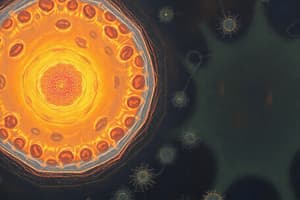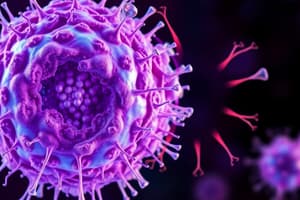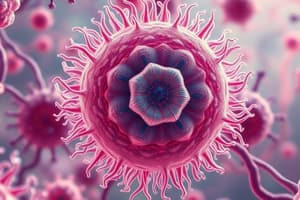Podcast
Questions and Answers
What is the primary function of ribosomes in prokaryotic cells?
What is the primary function of ribosomes in prokaryotic cells?
- Cell division
- Protein synthesis (correct)
- Nuclear membrane formation
- Energy production
What is the primary limitation of light microscopy?
What is the primary limitation of light microscopy?
- Requires a vacuum to operate
- Can only observe living cells
- Uses electron beams for visualization
- Can resolve objects down to about 200 nm (correct)
Which type of microscopy uses streams of accelerated electrons?
Which type of microscopy uses streams of accelerated electrons?
- Electron microscopy (correct)
- Phase contrast microscopy
- Digital microscopy
- Light microscopy
What feature distinguishes eukaryotic cells from prokaryotic cells?
What feature distinguishes eukaryotic cells from prokaryotic cells?
What is one of the main roles of the endomembrane system?
What is one of the main roles of the endomembrane system?
What does the rough endoplasmic reticulum (RER) contain that is crucial for protein synthesis?
What does the rough endoplasmic reticulum (RER) contain that is crucial for protein synthesis?
What is the purpose of the nuclear envelope?
What is the purpose of the nuclear envelope?
How do electrons get focused in electron microscopy?
How do electrons get focused in electron microscopy?
What is one reason cells need to be small or have increased surface area?
What is one reason cells need to be small or have increased surface area?
Which component of the cell membrane primarily provides its fluid properties?
Which component of the cell membrane primarily provides its fluid properties?
What defines prokaryotic cells compared to eukaryotic cells?
What defines prokaryotic cells compared to eukaryotic cells?
Which statement best describes the endomembrane system?
Which statement best describes the endomembrane system?
What was one major contribution of Robert Brown in cell biology?
What was one major contribution of Robert Brown in cell biology?
Which statement about ribosomes is incorrect?
Which statement about ribosomes is incorrect?
According to the cell theory, what is the smallest unit that has properties of life?
According to the cell theory, what is the smallest unit that has properties of life?
Which of the following is a characteristic all cells share?
Which of the following is a characteristic all cells share?
What is the primary function of the smooth endoplasmic reticulum (SER)?
What is the primary function of the smooth endoplasmic reticulum (SER)?
What is the role of the Golgi body in the cell?
What is the role of the Golgi body in the cell?
Which organelle is primarily responsible for producing ATP in cells?
Which organelle is primarily responsible for producing ATP in cells?
What does the endosymbiotic theory suggest about mitochondria and chloroplasts?
What does the endosymbiotic theory suggest about mitochondria and chloroplasts?
What is the main function of lysosomes in the cell?
What is the main function of lysosomes in the cell?
Which organelle is responsible for the synthesis of starch in plant cells?
Which organelle is responsible for the synthesis of starch in plant cells?
What key process does apoptosis refer to in cellular biology?
What key process does apoptosis refer to in cellular biology?
What is the primary action of caspases in relation to apoptosis?
What is the primary action of caspases in relation to apoptosis?
What is the primary composition of microtubules?
What is the primary composition of microtubules?
Which cytoskeletal element is composed of actin?
Which cytoskeletal element is composed of actin?
How do kinesins and dyneins function in relation to the cytoskeleton?
How do kinesins and dyneins function in relation to the cytoskeleton?
What structural formation characterizes flagella and cilia?
What structural formation characterizes flagella and cilia?
Which cytoskeletal component is the most stable and only found in certain animal tissues?
Which cytoskeletal component is the most stable and only found in certain animal tissues?
What is a key function of the primary cell wall in plants?
What is a key function of the primary cell wall in plants?
What role do plasmodesmata play in plant cells?
What role do plasmodesmata play in plant cells?
What materials primarily compose the secondary cell wall of plant cells?
What materials primarily compose the secondary cell wall of plant cells?
Flashcards
Cell Theory
Cell Theory
A set of three principles describing cells: (1) all organisms are made of one or more cells; (2) cells are the basic functional units of life; (3) new cells arise from pre-existing cells.
Prokaryotic Cell
Prokaryotic Cell
A type of cell that lacks membrane-bound organelles and has its DNA in a nucleoid region. Examples include bacteria and archaea.
Eukaryotic Cell
Eukaryotic Cell
A type of cell that has membrane-bound organelles and a nucleus containing its DNA. Examples include animal, plant, fungi, and protist cells.
Cell Size
Cell Size
Signup and view all the flashcards
Cell Membrane
Cell Membrane
Signup and view all the flashcards
Ribosomes
Ribosomes
Signup and view all the flashcards
Endomembrane System
Endomembrane System
Signup and view all the flashcards
Surface Area-to-Volume Ratio
Surface Area-to-Volume Ratio
Signup and view all the flashcards
Prokaryotic Ribosomes
Prokaryotic Ribosomes
Signup and view all the flashcards
Light Microscope Limitations
Light Microscope Limitations
Signup and view all the flashcards
Electron Microscope
Electron Microscope
Signup and view all the flashcards
Organelle Benefit
Organelle Benefit
Signup and view all the flashcards
Nuclear Envelope
Nuclear Envelope
Signup and view all the flashcards
Endoplasmic Reticulum (ER)
Endoplasmic Reticulum (ER)
Signup and view all the flashcards
RER's Role
RER's Role
Signup and view all the flashcards
SER's Function
SER's Function
Signup and view all the flashcards
Golgi Body's Tasks
Golgi Body's Tasks
Signup and view all the flashcards
Vesicles' Role
Vesicles' Role
Signup and view all the flashcards
Mitochondria's Power
Mitochondria's Power
Signup and view all the flashcards
Chloroplasts' Role
Chloroplasts' Role
Signup and view all the flashcards
Endosymbiotic Theory
Endosymbiotic Theory
Signup and view all the flashcards
Apoptosis: Programmed Cell Death
Apoptosis: Programmed Cell Death
Signup and view all the flashcards
Cytoskeleton
Cytoskeleton
Signup and view all the flashcards
Microtubules
Microtubules
Signup and view all the flashcards
Microfilaments
Microfilaments
Signup and view all the flashcards
Intermediate Filaments
Intermediate Filaments
Signup and view all the flashcards
Motor Proteins
Motor Proteins
Signup and view all the flashcards
Flagella and Cilia
Flagella and Cilia
Signup and view all the flashcards
Plant Cell Wall
Plant Cell Wall
Signup and view all the flashcards
Plasmodesmata
Plasmodesmata
Signup and view all the flashcards
Study Notes
Cell Structure and Function
- The image shows a historical depiction of Thames water, labeled "Monster Soup," meant to represent the inaccuracies in understanding cells prior to proper technology.
- Knowledge advances have led to improved understanding of cells.
- Cells generally are small or have an increased surface area.
- Membranes within cells form compartments for different processes.
- Endomembrane systems are a group of related organelles involved in lipid assembly, polypeptide chain modification, and product sorting/shipping.
- Endosymbiotic theory suggests that mitochondria and chloroplasts evolved from prokaryotes.
- There are similarities and differences between prokaryotic and eukaryotic cells.
Major Cell Themes
- Technological advances improve cell knowledge.
- Cells need a high surface area to volume ratio.
- Membranes create cellular compartments.
- Endomembrane systems are important for efficient cellular processes.
- Endosymbiotic theory explains the origin of mitochondria and chloroplasts.
- Prokaryotic and eukaryotic cells differ in their structures and function.
Early Cell Discoveries
- Hooke (mid-1600s) observed and described "cells" in cork.
- Leeuwenhoek (late-1600s) observed "animalcules" (living cells).
- Brown identified and named plant cells in the early 1800s.
Cell Theory
- All organisms are composed of one or more cells (Schwann).
- Cells are the smallest units with life characteristics (Schleiden).
- Cells arise from pre-existing cells (Virchow).
Two Types of Cells
Prokaryotic Cells
- Lack organelles.
- Cytoplasm contains ribosomes.
- DNA is in a nucleoid region.
- May have external structures like cell walls or capsules.
- Eubacteria and Archaea are examples.
Eukaryotic Cells
- Contain organelles with specialized functions.
- DNA is enclosed in a nucleus.
- Some have cell walls (e.g., plant cells).
- Animal, plant, fungi, and protists are examples.
All Cells: General Characteristics
- Smallest units of life.
- Can survive independently or as part of a larger organism.
- Highly organized for metabolism.
- Sense and respond to their environment.
- Can reproduce.
Cell Membranes
- The main component of cell membranes is a lipid bilayer (two layers of phospholipids).
- The lipid bilayer gives membranes their fluid properties.
- Phospholipids have a hydrophilic head and hydrophobic tails.
Cell Size and Surface Area-to-Volume Ratio
- Cells are small to maintain a favorable surface area-to-volume ratio.
- Cell volume determines metabolic activity relative to time.
- Surface area determines the number of substances entering or leaving the cell.
Ribosomes
- Cells manufacture polypeptides with ribosomes.
- Ribosomes are not membrane-bound in eukaryotes, but can be free in cytoplasm, attached to endoplasmic reticulum, or inside mitochondria/chloroplasts.
- In prokaryotic cells, ribosomes freely float within cytoplasm.
- Ribosomes consist of ribosomal RNA and provide sites for protein synthesis.
Microscopes
Light Microscopes
- Create detailed images of small things otherwise too small to see.
- Can be simple or compound.
- Resolution is limited by the wavelength of light (about 200 nanometers).
Electron Microscopes
- Use accelerated electron beams instead of light.
- Electrons are focused by magnets instead of glass lenses.
- Resolution is far greater than light microscopes.
- Types of electron microscopes include scanning electron (SEM) and transmission electron (TEM).
Eukaryotic Cells
- Contain a nucleus and other organelles.
- Include the kingdoms of plants, animals, protists, and fungi.
Organelles
- Benefit of organelles is cellular compartmentalisation to allow specific processes to occur in distinct areas.
Animal Cell Features (examples)
- Nucleus
- Nuclear envelope
- Nucleolus
- Chromatin
- Smooth and Rough Endoplasmic Reticulum
- Ribosomes
- Golgi apparatus
- Lysosomes
- Mitochondria
- Cytosol
- Centrioles
- Centrosome
- Microvilli
- Intermediate filaments
- Microtubules
- Peroxisomes
Plant Cell Features (examples)
- Cell wall
- Plasma membrane
- Nucleus
- Nuclear envelope
- Nucleolus
- Rough and Smooth Endoplasmic Reticulum
- Ribosomes
- Golgi apparatus
- Mitochondria
- Chloroplasts
- Vacuoles
- Cytosol
- Intermediate filaments
- Microtubules
Nucleus: Structure and Function
- Keeps DNA separate from cytoplasm.
- Facilitates DNA organization and replication.
Nuclear Envelope
- Composed of two lipid bilayers.
- The innermost surface has DNA attachment sites.
Endomembrane System: Components
- Endoplasmic reticulum
- Vesicles
- Golgi Apparatus
Endoplasmic Reticulum
- Continuous with nuclear membrane in animal cells.
- Rough ER modifies polypeptides.
- Smooth ER synthesizes lipids, metabolizes carbohydrates, and detoxifies.
Golgi Body
- Receives proteins from ER.
- Modifies, packages, sorts proteins.
- Adds carbohydrates to proteins.
- Synthesizes polysaccharides (plants).
- Packages material for final destinations.
Vesicles
- Transports material within cytoplasm (e.g., lysosomes, transport, peroxisomes).
Dynamic Cell Membranes
- Consistently being made, recycled, and decomposed.
Mitochondria and Chloroplasts
- ATP-producing "powerhouses."
- Have internal compartments.
- The machinery for ATP production is embedded in the inner mitochondrial membrane.
- Convert sunlight energy to the energy of organic sugars.
Endosymbiotic Theory
- Mitochondria and chloroplasts have features resembling bacteria.
- Have their own DNA and ribosomes.
- Divide independently.
- Likely evolved by being engulfed by larger prokaryotic cells but not digested.
Specialized Plant Organelles
- Plastids (chromoplasts, amyloplasts)
- Central vacuole
Other Plastids
- Chromoplasts: Lack chlorophyll, abundant carotenoids; color fruits/flowers.
- Leucoplasts: Lack pigments; store starch.
Apoptosis
- Programmed cell death involving the sequence of events to destroy a cell.
- Nucleus fragments, cell membrane blisters or blebs form, and cell fragments are engulfed by cells.
- Caspases (enzymes) cause apoptosis.
- Mitosis and apoptosis are opposing forces.
Autophagy
- Self-eating process of cells engulfing parts and recycling them.
Cytoskeleton
- Present in all eukaryotic cells; basis of shape and internal organization.
- Allows organelle and cell movement (motility).
Cytoskeleton Elements
- Microtubules
- Microfilaments
- Intermediate filaments
Microtubules
- Largest components of cytoskeleton.
- Composed of tubulin.
- Involvement in shape, motility, and cell division.
Microfilaments
- Thinnest cytoskeletal elements.
- Composed of actin.
- Movement, formation, and maintenance of cell shape.
Intermediate Filaments
- Only in animal cells of certain tissues.
- Most stable cytoskeletal elements.
Motor Proteins
- Kinesins and dyneins; move along microtubules.
- Myosins; move along microfilaments.
Flagella and Cilia
- Structures for cell motility.
- 9 + 2 internal structure (microtubules).
Plant Cell Walls
- Secondary cell wall (made of cellulose and lignin)
- Primary cell wall (made of polysaccharides, glycoproteins, and cellulose)
- Plant cells are connected by plasmodesmata.
Plant Cuticle
- Cell secretions and waxes form a layer covering the surface of the plant cell.
- Semitransparent.
- Restricts water loss.
Matrices between Animal Cells
- Hold cells together in tissues
- Contributes to properties of cartilage, skin and other tissues.
- Filters materials.
- Orients cell movement.
Plant Cell Junctions
- Plasmodesmata connect adjacent plant cells.
- The plasma membranes of adjacent cells are continuous.
- Water and solutes pass freely between cells.
Animal Cell Junctions
- Tight junctions: anchor cells together to form tissues.
- Desmosomes: anchor tissue cells and allow cells to stretch.
- Gap junctions: communication between cells.
Prokaryotic Cells
- Two kingdoms: Archaea and Eubacteria.
- DNA not enclosed in a nucleus (nucleoid region).
- Plasmids: small circular pieces of DNA.
- Generally the smallest, simplest cell type.
- Lack organelles but possess ribosomes.
- Some have flagella but structure differs from eukaryotic flagella.
Prokaryotic Cell Structures
- Capsule, cell wall, plasma membrane, cytoplasm, inclusions, ribosomes, plasmids, flagella, and pili are components of prokaryotic cells.
Studying That Suits You
Use AI to generate personalized quizzes and flashcards to suit your learning preferences.




